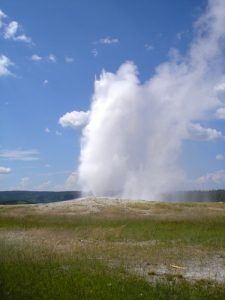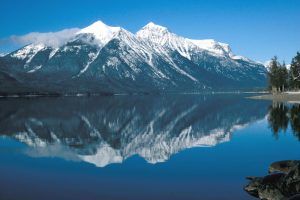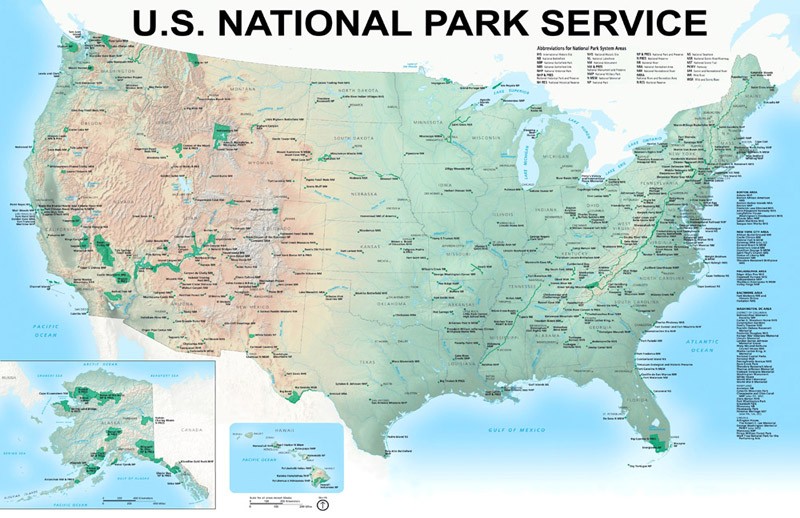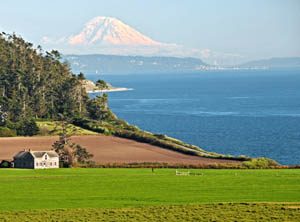
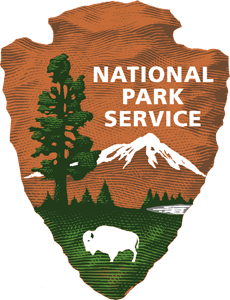
National Parks, Monuments & Historic Sites
National Battlefields & Military Parks
National Historic Sites & Parks
National Memorials & Monuments
National Parks
National Preserves & Reserves
National Recreation Areas, Rivers, & Seashores
National Trails & Parkways
Other Designations
Since 1916, the National Park Service has been entrusted with caring for United States national parks. With the help of volunteers and partners, it safeguards these special places and shares their stories with more than 318 million visitors every year.
Many of America’s most scenic and historic places have been set aside for the public’s use as national parks. The concept of a “national park” is an American innovation that, in part, grew out of the conservation movement that began in the 19th century. Yellowstone National Park was established as the nation’s first national park by an act signed by President Ulysses S. Grant on March 1, 1872. It was the first such park in the world. However, the National Park Service was not established until 1916.
It is no coincidence that the first national park was explored and established in the same decade that saw the publication of many articles and books about nature and wilderness. Several writers associated with the national park movement, including Clarence Dutton, Ferdinand V. Hayden, Clarence King, Nathaniel P. Langford, John Muir, and John Wesley Powell, described the spectacular scenery of the western United States. The Appalachian Mountain Club, one of the first private conservation organizations, was founded in 1876 to protect and preserve eastern wilderness areas. The United States Geological Survey, which undertook responsibility for surveying and mapping lands in the national domain, was established as a separate bureau within the Department of the Interior in 1879.
For four decades, the Departments of War, Agriculture, and the Interior supervised the nation’s parks, reserves, and monuments at different times. Although the idea of national parks enjoyed broad popular and congressional support by the early 20th century, there was some resistance to converting reserves and monuments into new national parks.
This was partially the result of a lack of coordinated policy and leadership in financing and administering the existing parks. Stephen Tyng Mather was appointed the first Superintendent of Parks (1915-29) and did much to alter the situation. Mather was a leader in transforming the poorly managed and underfinanced national parks and monuments into the centrally administered National Park Service. On August 25, 1916, President Woodrow Wilson signed the “Organic Act,” creating the National Park Service, a federal bureau in the Department of the Interior responsible for maintaining national parks and monuments that the department then managed.
In 1916, there were already 35 national parks and monuments, including Yellowstone, Mackinac Island, Yosemite, Mount Rainer, Glacier, Rocky Mountain, Mesa Verde, Devils Tower, El Morro, and Montezuma Castle.
Under Superintendent Mather’s dynamic leadership, the Grand Canyon, Acadia, Bryce, Zion, Lassen, Hawaii, and Mount McKinley National Parks were established. He also successfully lobbied for enabling legislation that ensured the future creation of other parks, such as the Great Smoky Mountains, Shenandoah, and Mammoth Cave.
The burgeoning of American national parks reflected contemporary intellectual, social, and economic changes that led to a growing appreciation for wilderness and wildlife, a desire to escape the increasingly urban places that resulted from industrialization, and the popularization of the automobile. With increased awareness of and sensitivity toward nature came the desire to preserve some of the most spectacular landscapes and significant historical and cultural sites for the enjoyment of future generations. Americans wanted to visit these places to experience their beauty firsthand, whether they traveled by train, steamship, or, increasingly, by automobile.
The National Park System has since expanded to 429 parks, more than 150 related areas, and numerous programs that assist in conserving the nation’s natural and cultural heritage for the benefit of current and future generations. These parks cover over 85 million acres in all 50 states, the District of Columbia, and U.S. territories. These areas include national parks, monuments, preserves, reserves, lakeshores, seashores, wild and scenic riverways and trails, historic sites and parks, military parks and battlefields, memorials, recreation areas, historic sites, parkways, and the White House.
The National Park Service preserves unimpaired the natural and cultural resources and values of the National Park System for the enjoyment, education, and inspiration of this and future generations. The Service cooperates with partners to extend the benefits of natural and cultural resource conservation and outdoor recreation.
The National Park Service is proud that Native American tribes, local governments, nonprofit organizations, businesses, and individual citizens ask them for help revitalizing their communities, preserving local history, celebrating local heritage, and creating close-to-home opportunities for kids and families to get outside, be active, and have fun.
The organization employs approximately 20,000 people plus more than 200,000 volunteers who are passionate about caring for the nation’s special places and sharing their stories.
Wrangell-St. Elias National Park and Preserve in Alaska is the largest park at 13.2 million acres. Thaddeus Kosciuszko National Memorial in Pennsylvania is the smallest at 0.02 acres.
Today’s national parks are public resources for recreation, education, scholarship, and preserving endangered landscapes, natural communities, and species. They exist in twenty-five states and the Virgin Islands and include areas as diverse as the “river of grass” that makes up the Everglades, the mountains and valleys of Yosemite, the volcanoes of Hawaii, and the Denali Wilderness of Alaska. Some of them were purchased by private individuals who then generously gave them to the nation; others were taken from the public domain to protect them from agricultural or commercial development and exploitation.
Compiled Kathy Alexander/Legends of America, March 2024.
Also See:
Scenic Byways & Historic Trails
Sources:
Library of Congress
Library of Congress Blog
National Park Service
Wikipedia

